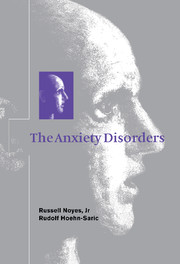Book contents
- Frontmatter
- Contents
- Preface
- 1 Normal anxiety and fear: psychological and biological aspects
- 2 Generalized anxiety disorder
- 3 Panic disorder and agoraphobia
- 4 Social phobia
- 5 Specific phobia
- 6 Posttraumatic stress disorder
- 7 Anxiety in the medically ill: disorders due to medical conditions and substances
- Index
6 - Posttraumatic stress disorder
Published online by Cambridge University Press: 22 March 2010
- Frontmatter
- Contents
- Preface
- 1 Normal anxiety and fear: psychological and biological aspects
- 2 Generalized anxiety disorder
- 3 Panic disorder and agoraphobia
- 4 Social phobia
- 5 Specific phobia
- 6 Posttraumatic stress disorder
- 7 Anxiety in the medically ill: disorders due to medical conditions and substances
- Index
Summary
Definition
Posttraumatic stress disorder (PTSD) consists of a clearly defined syndrome that develops in the aftermath of a traumatic experience and that persists longer than 1 month. Shorter reactions to stressors or traumatic events are classified as acute stress reaction or, when milder, as adjustment disorders (American Psychiatric Association, 1994). While DSM-III and its subsequent modifications eliminated theoretical or aetiological explanations for psychiatric disorders and substituted a descriptive approach, an exception was made for these three disorders by linking them etiologically to specific adverse events (Brett et al., 1988). As PTSD is the more serious and usually more enduring disorder, most of this chapter deals with PTSD.
The impact of traumatic events on the psyche has been described by poets since antiquity. Vivid descriptions of traumatic reactions are provided by Shakespeare, whose Lady Macbeth cannot free her mind of Duncan's murder, and by Pushkin, whose Boris Godonov is plagued by memories of the murdered Zarevich. Samuel Peppy's diary records his reaction to the Great Fire of London in 1666, including anxiety, insomnia, nightmares and feelings of guilt for having saved himself and his property (Daly, 1983). In the nineteenth century, physicians became observant of the psychological and psychophysiological effects of massive trauma. They described physical and mental exhaustion and ‘neurasthenia’ in soldiers exposed to fighting in the American Civil War. A syndrome consisting of physical symptoms, phobias, nightmares and nervousness was named ‘irritable heart’ by DaCosta (Ramsay, 1990). During World War I similar symptoms in soldiers exposed to combat were called ‘shell shock’ and were attributed to brain injury.
- Type
- Chapter
- Information
- The Anxiety Disorders , pp. 236 - 284Publisher: Cambridge University PressPrint publication year: 1998



